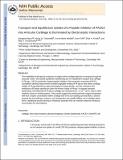| dc.contributor.author | Byun, Sangwon | |
| dc.contributor.author | Tortorella, Micky D. | |
| dc.contributor.author | Malfait, Anne-Marie | |
| dc.contributor.author | Fok, Kam | |
| dc.contributor.author | Grodzinsky, Alan J. | |
| dc.contributor.author | Frank, Eliot | |
| dc.date.accessioned | 2015-09-17T17:09:14Z | |
| dc.date.available | 2015-09-17T17:09:14Z | |
| dc.date.issued | 2010-05 | |
| dc.date.submitted | 2010-04 | |
| dc.identifier.issn | 00039861 | |
| dc.identifier.issn | 1096-0384 | |
| dc.identifier.uri | http://hdl.handle.net/1721.1/98536 | |
| dc.description.abstract | The availability of therapeutic molecules to targets within cartilage depends on transport through the avascular matrix. We studied equilibrium partitioning and non-equilibrium transport into cartilage of Pf-pep, a 760 Da positively charged peptide inhibitor of the proprotein convertase PACE4. Competitive binding measurements revealed negligible binding of Pf-pep to sites within cartilage. Uptake of Pf-pep depended on glycosaminoglycan charge density, and was consistent with predictions of Donnan equilibrium given the known charge of Pf-pep. In separate transport experiments, the diffusivity of Pf-pep in cartilage was measured to be ~1 × 10[superscript −6] cm[superscript 2]/s, close to other similarly-sized non-binding solutes. These results suggest that small positively charged therapeutics will have a higher concentration within cartilage than in the surrounding synovial fluid, a desired property for local delivery; however, such therapeutics may rapidly diffuse out of cartilage unless there is additional specific binding to intra-tissue substrates that can maintain enhanced intra-tissue concentration for local delivery. | en_US |
| dc.description.sponsorship | National Institutes of Health (U.S.) (Grant AR45779) | en_US |
| dc.description.sponsorship | National Institutes of Health (U.S.) (Grant AR33236) | en_US |
| dc.description.sponsorship | Pfizer Inc. | en_US |
| dc.language.iso | en_US | |
| dc.publisher | Elsevier | en_US |
| dc.relation.isversionof | http://dx.doi.org/10.1016/j.abb.2010.04.019 | en_US |
| dc.rights | Creative Commons Attribution-Noncommercial-NoDerivatives | en_US |
| dc.rights.uri | http://creativecommons.org/licenses/by-nc-nd/4.0/ | en_US |
| dc.source | PMC | en_US |
| dc.title | Transport and equilibrium uptake of a peptide inhibitor of PACE4 into articular cartilage is dominated by electrostatic interactions | en_US |
| dc.type | Article | en_US |
| dc.identifier.citation | Byun, Sangwon, Micky D. Tortorella, Anne-Marie Malfait, Kam Fok, Eliot H. Frank, and Alan J. Grodzinsky. “Transport and Equilibrium Uptake of a Peptide Inhibitor of PACE4 into Articular Cartilage Is Dominated by Electrostatic Interactions.” Archives of Biochemistry and Biophysics 499, no. 1–2 (July 2010): 32–39. | en_US |
| dc.contributor.department | Massachusetts Institute of Technology. Center for Biomedical Engineering | en_US |
| dc.contributor.department | Massachusetts Institute of Technology. Department of Biological Engineering | en_US |
| dc.contributor.department | Massachusetts Institute of Technology. Department of Electrical Engineering and Computer Science | en_US |
| dc.contributor.department | Massachusetts Institute of Technology. Department of Mechanical Engineering | en_US |
| dc.contributor.mitauthor | Byun, Sangwon | en_US |
| dc.contributor.mitauthor | Frank, Eliot | en_US |
| dc.contributor.mitauthor | Grodzinsky, Alan J. | en_US |
| dc.relation.journal | Archives of Biochemistry and Biophysics | en_US |
| dc.eprint.version | Author's final manuscript | en_US |
| dc.type.uri | http://purl.org/eprint/type/JournalArticle | en_US |
| eprint.status | http://purl.org/eprint/status/PeerReviewed | en_US |
| dspace.orderedauthors | Byun, Sangwon; Tortorella, Micky D.; Malfait, Anne-Marie; Fok, Kam; Frank, Eliot H.; Grodzinsky, Alan J. | en_US |
| dc.identifier.orcid | https://orcid.org/0000-0002-4942-3456 | |
| mit.license | PUBLISHER_CC | en_US |
| mit.metadata.status | Complete | |
